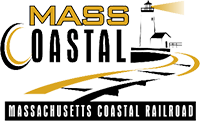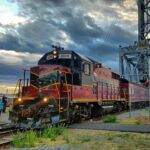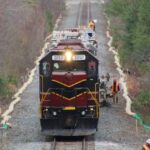Save Cape Rail
When the First and Last Miles are the Most Important
Ripping Up Railroad Tracks in Falmouth for Bike Path Makes No Sense
Cape Cod Times OP-ed
A Letter from Mass Coastal President and CEO P. Christopher Podgurski as quoted in The Cape Cod Times
I am writing in response to the recent Cape Cod Times article regarding the proposed bike path on the Falmouth Secondary rail line. (March 16) To start off with, the government officials who are proposing the removal of the rail infrastructure in favor of the bike path are among the same cast of characters who have sponsored other similar actions. Namely the removal of the rail line between Falmouth Center and North Falmouth.
Just imagine today if the seasonal Cape Flyer train that runs between Boston and Hyannis also arrived at The Steamship Authority satellite parking area in Falmouth, or even, heaven forbid, pulled into Woods Hole to disgorge its passengers to the ferries! Transportation at its finest I’d say? Responsible, even to say the least? Back then the likes of former Falmouth Select Board member and state Rep. Eric Turkington saw fit to sneak language into a bill that sealed the fate of the existing railroad tracks.
Fast forward to 2023, my company, Mass Coastal Railroad (MCR) operates the 58.5 miles of railroad known as the Southeast Mass Lines, of which the Falmouth Secondary track is but one segment. In the years since MCR operated the lines, traffic to and from Joint Base Cape Cod, formerly the Massachusetts Military Reservation, has wavered from some to none. In 2022 we moved over 300 railcars per year of solid waste from the Otis transfer station on the base.
In 2023 we are forecasting that car volume to double. Why? One only has to take a look at the Cape Cod Commission’s report done by GEOSYNTEC Consultants in which the municipal solid waste and construction and demolition waste disposal alternatives clearly point out that waste-by-rail is the future. Why again you ask? Because the landfills that have existed in the Northeast are full or at capacity. I am supposing that the Cape Cod Commission’s intent was two-fold. The first is the preservation of the Cape’s ecosystem and, the second is the potential cost to the average citizen and taxpayer going forward. That is not in the mind of the bike path dreamers.
Sure, put the 3,500-plus truck trips that are saved by the Otis tracks back onto the highways and the fragile canal bridges. In the name of what?
Speaking of that, I find it very curious that the $20 million in federal funds that have been offered by the Cape Cod Regional Transit Authority is earmarked for transportation needs. In reading the rationale, the proximity of bus stops to the bike trail is reason enough to create bike paths? I’d love to see the study that backed that statement up. Clearly, when considering this path, the local proponents and politicians have overlooked the fact that the 6 miles of rail line would require tens of millions of dollars just to remove the 2 to 3 vertical feet of roadbed that contains coal cinders, arsenic and cyanide from nearly 200 years of rail operations. Of course, they’re not telling the public that, which is disingenuous at best.
“The Alternative”?
I was presented with a PDF prepared by the Friends of the Bourne Rail Trail, explaining an alternative to relocating the rail infrastructure to Joint Base Cape Cod via a series of tunnels and bridges that begin at just above water level at the Cape Cod Canal. The proposal would be up to 95 vertical feet in depth traveling under and around the location of the proposed Bourne Bridge replacement. Passing directly under the on- and off-ramps to the bridge. This feat in itself labels this “solution” as a civil construction challenge at best, a nightmare and expensive at least. Combine the engineering “feat” above with the construction of 2 miles of railroad (path crosses under a pond), and frankly, I call it impossible to construct.
By the way, this alternative solution shows the track terminating within the Bourne landfill. Obviously, we know what that will do to the waste streams of Sandwich, Mashpee and Falmouth. It will force waste from those towns to be trucked at a significant cost to the taxpayers and would create an increase in the region’s carbon footprint.
In closing, I find it quite interesting that the officials now open to removing the rail line are curiously missing important organizations such as the Secretary of Transportation or the Massachusetts Department of Transportation Rail and Transit Division. In discussion with the rail division officials recently, they have not been contacted in recent history, nor have they waivered on their position to maintain the Falmouth Branch. MCR and MassDOT have previously assented to rail-with-trail on this active rail line. These folks should stop spinning their wheels and concentrate on the big picture.
Additionally, the commercial railroad customer Cavossa Enterprises, which has the federal contract to operate the transfer station at Otis Air National Guard Base, is protected by the United States Surface Transportation Board, 49 U.S.C. 10101-11908. These regulations are in place specifically to protect the railroads but more importantly railroad customers.
In The News
Q&A
Frequently Asked Questions
What is the Massachusetts Coastal Railroad?
The Massachusetts Coastal RR (MCRR) is a freight railroad that operates just under 100 miles of railroad tracks in Southeastern Massachusetts. We also maintain and operate an additional 44 miles of railroad owned by the Commonwealth of Massachusetts that extends north to Framingham. For service outside the region via the National Rail Network, MCRR connects with CSX, one the country’s largest nationwide freight railroads, in two places. The first is at an interchange in Taunton for the New Bedford/ Fall River Lines and the second is in Middleboro for rail traffic on and off Cape Cod.
MCRR serves approximately a dozen customers and provides jobs for more than 60 people. The railroad indirectly supports thousands of jobs at dozens of Massachusetts companies. MCRR owns and operates 10 locomotives that service freight hauling on the tracks in our system.
How does the MCRR benefit the Cape?
Transporting freight by railroad is a much better option than trucks when it comes to hauling heavy, dense loads over long distances. Railroads are roughly four times more fuel efficient than trucks. Meanwhile, shipping via rail limits greenhouse gas emissions and reduces the carbon footprint. In fact, moving freight by rail instead of truck lowers greenhouse gas emissions for moving that cargo by 75%.
On Cape Cod, the transportation of common household waste (known as Municipal Solid Waste, or MSW) and Construction Demolition Debris (C&D) from towns on the lower Cape currently occurs over rail. Hundreds of thousands of tons of waste filling thousands of railcars
are collected at transfer stations on the Cape and shipped by rail to landfills all along the eastern seaboard every month.
Many other cargoes travel by rail onto the Cape, as well. These include treatments for clean drinking water, flour, frozen seafood, malt beverages and feed ingredients like corn, canola meal, beet pulp and distillers mash.
In addition, our trains carry steel, lumber, wallboard scrap metal and roadway safety treatments. We also haul transformers and other dimensional heavy loads.
How does MCRR reduce traffic on the Cape’s roads and bridges?
In addition to other benefits, moving cargo by rail reduces the wear and tear – and traffic – on the Cape Cod Canal Bridges and other highways in Massachusetts.
The MCRR’s “Energy Train” operates between Yarmouth and West Wareham transporting MSW from the Yarmouth Transfer Station to the “SEMASS” power plant in Rochester, MA that generates electricity for thousands of local homes and businesses. Over 130,000 tons of
household waste, or MSW, is transported off the Cape by rail annually, reducing congestion on the Cape’s highways and bridges with a much lower carbon footprint than if it were hauled by truck.
Similarly, the MCRR’s waste hauling operations on the Falmouth Secondary Line eliminates thousands of truck trips on Routes 28, 25 and I-495 in both directions on the Bourne Bridge.
All this rail activity occurs on the “Third Bridge” over the Canal.
Note** See Cape Cod Commission 2020 Regional Transportation Plan Appendix E Summary. Encourage types of Freight Transportation and Make Infrastructure Improvements for the Same.
What is the Cape Cod Central Railroad? What is its relationship to MCRR?
CCCR is a popular, important tourist attraction which runs from April through December on the Falmouth Secondary Line and the Cape Main Line which runs from Hyannis to Bourne. It boosts the local economy and creates indirect economic benefits for Cape-based companies and residents. The train offers dinner, lunch and brunch, excursions, and special event trains. These include Rails & Ales Beer Tasting Train and a wine tasting train highlighting products from local breweries and wineries. It also offers the popular Polar Express Train Ride, a Christmas train which hosts 30,000 people from around New England, and beyond, creating economic activity on the Cape during the “off season”.
The CCCR is a sister railroad to MCRR, with common ownership. It does not haul freight.
What is the Falmouth Secondary Rail Line?
The Falmouth Secondary Line, constructed in 1872, runs generally north/south for six miles from the Cape Cod Canal railroad bridge through Bourne, Sandwich and Falmouth. It ends near Rt. 151 in North Falmouth. The line is a valuable, essential piece of rail infrastructure for Cape Cod.
The Otis Branch runs east for about 3 miles from the Falmouth Secondary near Rt. 151 onto the Mass Military Reservation, formerly Otis Air Force Base. The Otis Branch terminates at the Upper Cape Regional Transfer Station (“UCRTS”).
Owned by the Massachusetts Department of Transportation (“MASSDOT“) the Falmouth Secondary line is part of what is known as the Southeastern Mass Rail Lines. These rail asset were purchased from CONRAIL in 1982 for the purposes of preserving freight rail service for the Cape. Since then, the SE Mass lines have been operated by MCRR under a license issued by MASSDOT. The Freight Rights are administered separately by the U.S. Surface Transportation Board (USSTB), a federal agency.
How does the region benefit from the Falmouth Secondary Line?
The region benefits from the Falmouth Secondary Line in much the same way that is does from MCRR’s, with a significant reduction in truck traffic on Cape roads and bridges and a significantly reduced carbon footprint from hauling freight. It keeps nearly 1,000 trucks off Cape roads and bridges every year, with a significant increase in that number envisioned in the near future.
What is the Bourne Rail Trail?
The Bourne Rail Trail is a proposed, taxpayer funded $20 million bike path that would entirely remove the Falmouth Secondary line, and eliminate the benefits created by the more than 150 year-old rail line.
What would be the impact if the Falmouth Secondary Line were to be eliminated for a bike path?
Removing the Falmouth Secondary Line tracks would permanently eliminate the existing rail capacity the line creates, crippling freight rail service on the Cape. It would also negatively impact the ability of the MCRR to serve the region as a whole. Replacing the Falmouth Secondary Line with a bike path would also add thousands of trucks to the Cape’s already congested roads and bridges, while creating a spike in the emission of greenhouse gases in our communities.
How would the people of the Cape be impacted if the Falmouth Secondary Line were to be eliminated for a bike path?
Thousands of tractor trailers hauling all kinds of trash would be added to the traffic mix on the Cape’s roads and bridges. These trucks would drive onto the Cape empty and leave full of trash. Taxpayers, homeowners and businesses would see major increases in disposal costs. Everyone would incur an added expense, with higher costs for transfer station customers, higher taxes and other negative impacts.
How many additional trucks would be added to Cape traffic if the Falmouth Secondary Line were to be eliminated for a bike path?
Over 9,000 truck trips would be added at present volumes of C&D waste alone. It’s important to note that a truck hauling trash (instead of that waste leaving the Cape on Falmouth Secondary Line) would travel to the Cape empty, then be loaded with trash for the trip off the Cape.
Has the MCRR proposed a compromise that would allow the community to both retain the rail capacity and allow for the construction of a new bike path?
Yes – the MCRR always conducts business with the community in mind and is glad to work to find a compromise solution on important issues like this.
What compromise approach has the MCRR proposed?
The MCRR supports a “rail with trail alternative”. This would build the proposed $20 million taxpayer funded bike path parallel to the Falmouth Secondary Line, creating a new recreation asset for the community while preserving freight rail capacity for the Cape. A successful example of the “rail with trail” approach can already be seen in Falmouth where the Shining Sea Bike Path and the Falmouth Secondary Line share the right of way south of County Road. Another example of this successful compromise approach can be seen in nearby Rhode Island, where a popular bike path and a heavily used, existing freight rail line operate side-by-side along the Blackstone River in Cumberland, R.I.




